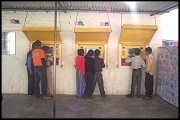 Children in Remote Villages in India Teaching Themselves to use Computers Instinctively – with No Help from Adults
Children in Remote Villages in India Teaching Themselves to use Computers Instinctively – with No Help from Adults
An IT engineer in India was gazing out his office window at the poverty-ridden shanty town located just outside the walls of his sleek hi-tech corporate compound. This irony led to inspiration. Computer skills offer a better chance at success for these poor kids.
The BBC reports, “He decided it was time to break a hole in the wall and give the children outside a chance to see what a computer was. He cut a hole and hooked one up. What happened next amazed him. They taught themselves how to use it.”
The article gives fascinating detail on how that occurred.
Innovative kid-only computer kiosks (built to keep large adult hands out) are now being installed in the village squares of other impoverished areas.
The really interesting twist is, no one teaches the kids how to use the technology. They teach themselves. “The driving force behind Hole-in-the-Wall is the the concept of Minimally Invasive Education which is truly path breaking,” reads their Web site. Observing the children at the kiosks for four years has shown “children could learn on their own, something not many people would have imagined.”




















[…] Source: Poor Kids Can Figure Out Computers on Their Own – Good News Network […]